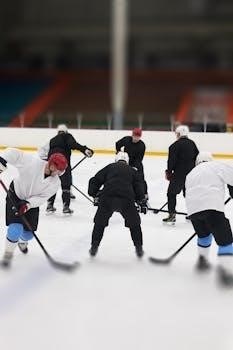Understanding hockey requires knowledge of its unique vocabulary. This guide offers a comprehensive overview of terms, from basic plays to slang. Mastering hockey terminology enhances enjoyment and understanding of the game.
Understanding the Need for a Hockey Terminology PDF
A hockey terminology PDF serves as an invaluable resource for anyone looking to engage with the sport more deeply. Whether you’re a new fan, a player, a coach, or a parent supporting a young athlete, having a readily accessible glossary of terms is essential. The fast-paced nature of hockey, coupled with its own unique jargon, can be confusing without a guide. A PDF format allows for easy access on various devices, facilitating quick look-ups during games or practice. It provides clarity on everything from basic terms like “assist” and “goal” to more complex tactical language, ensuring everyone is on the same page. Moreover, a comprehensive terminology PDF aids in understanding game analysis, broadcasts, and discussions, fostering a greater appreciation for the sport’s nuances and strategies. By having this information readily available, individuals can participate more fully in the hockey community and further enjoy the game.
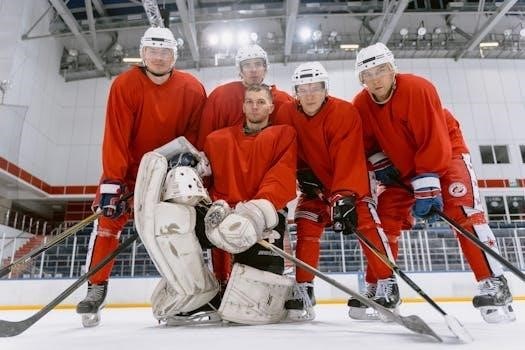
Basic Hockey Terms
This section introduces fundamental hockey terms. These include common offensive and defensive terms, essential for understanding the game’s basic flow and strategies.
Common Offensive Terms⁚ Assist, Attacking Zone, Goal
In hockey, an assist is awarded to a player who passes the puck to a teammate who scores a goal, with a maximum of two assists per goal. The attacking zone is the area of the ice where the team with possession of the puck is trying to score; it’s the area furthest from their own net. A goal is scored when the puck completely crosses the goal line and enters the net, earning a point for the scoring team. Offensive plays are designed to move the puck through the neutral zone into the attacking zone to create scoring chances. These fundamental concepts form the core of offensive strategy in hockey. Understanding them is crucial for following game progression and appreciating the execution of offensive plays.
Common Defensive Terms⁚ Backchecking, Defensive Zone, Checking
Backchecking is the defensive action of quickly skating back towards one’s own defensive zone to prevent the opposing team from scoring. The defensive zone is the area of the ice closest to a team’s own goal, where their primary focus is preventing the opposition from scoring. Checking, a key defensive tactic, involves using physical contact to separate an opponent from the puck or impede their progress. This includes body checking, which is allowed within specific rules. Effective defensive play is crucial for any team, focusing on disrupting the opponent’s attack and regaining possession of the puck. Proper execution of these terms are key for teams to maintain control and prevent goals during game play.
Ice Hockey Specific Terminology
Ice hockey has unique terms, distinct from other sports. Understanding these terms is crucial for following the game. This section will cover penalties and player positions.
Terms Related to Penalties⁚ Boarding
Boarding is a penalty in ice hockey, called when a player violently pushes, slams, or checks an opposing player into the boards in a dangerous manner. This action can result in significant injury, making it a serious infraction. The severity of the penalty, whether minor or major, depends on the force of the impact and the resulting harm to the player. Referees carefully watch for boarding situations, as player safety is paramount. Players are expected to avoid this type of play. It is not allowed in the sport and can result in suspensions and fines, and power play opportunities for the opposing team. It’s critical for all players to understand the ramifications of boarding.
Terms Related to Player Positions⁚ Center, Winger
In ice hockey, the center is a forward who plays a pivotal role in both offense and defense, positioned in the middle of the ice. The center is responsible for face-offs and often leads the offensive charge. Wingers, on the other hand, are forwards positioned on the left and right sides of the rink, flanking the center. They work in tandem with the center, focusing on scoring and assisting goals. Both wingers and the center need to be adept at both attacking and defensive roles. The team’s strategy relies heavily on their coordination and collaboration. Understanding these positions is essential for grasping game dynamics. They are integral to the team’s overall success on the ice.
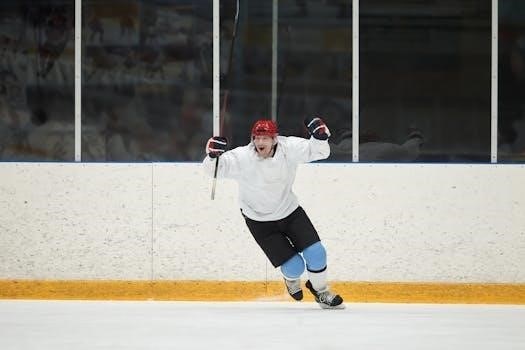
Hockey Skills and Tactics Terminology
Hockey involves specific skills and strategies. This section covers essential techniques like c-cuts, Indian dribble, and juggling, alongside tactics such as forechecking, backchecking, and breakouts.
Skills⁚ C-cuts, Indian Dribble, Juggling
C-cuts are a fundamental skating skill, crucial for forward movement and agility, helping players gain speed and control. The Indian dribble involves moving the ball from side to side using quick taps or drags, enhancing ball control and maneuverability, often considered a core skill. Juggling, bouncing the ball on the stick, is a practice technique that improves a player’s feel for the ball. These skills, among others, form the foundation of a hockey player’s abilities. Mastering these techniques is essential for any player looking to improve their overall performance on the field. These foundational skills contribute significantly to a player’s ability to handle the puck and navigate the ice effectively. Proper execution of these skills is paramount in competitive hockey.
Tactics⁚ Forechecking, Backchecking, Breakout
Forechecking is an offensive tactic where players apply pressure in the opponent’s defensive zone, aiming to regain possession of the puck and create scoring opportunities. Backchecking is a defensive strategy where players quickly retreat to their own zone to prevent the opposing team from scoring. A breakout is a tactical maneuver used by a team in their defensive zone to transition the puck to the offensive zone, using coordinated passes and skating. These tactics are essential for both offensive and defensive success in hockey. Understanding and implementing these strategies is crucial for any team looking to compete effectively. A well-executed breakout can quickly turn defense into offense, highlighting the importance of these tactical elements. These core tactics are the foundation of hockey gameplay.
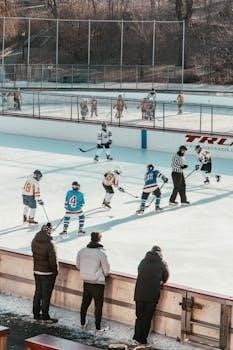
Slang and Informal Hockey Terms
Hockey slang adds color to the game. Terms like “apple” for assist and “five-hole” for the space between the goalie’s legs are common. These informal terms enrich the culture.
Examples of Hockey Slang
Hockey boasts a rich collection of slang terms that often baffle newcomers but are second nature to seasoned fans and players. An “apple,” for instance, isn’t a fruit but a synonym for an assist, a key contribution to a goal. The “five-hole” refers to the space between a goalie’s legs, a notoriously difficult spot to defend. When a player “undresses” an opponent, it means they’ve used a skillful move to get past them, often leaving them looking foolish. A “snipe” is a perfectly placed, powerful shot, while “chirping” is the act of trash-talking. Understanding these terms adds another layer of enjoyment to watching or playing the game, immersing you further into hockey’s unique culture. These terms make the game more colorful and fun to talk about.
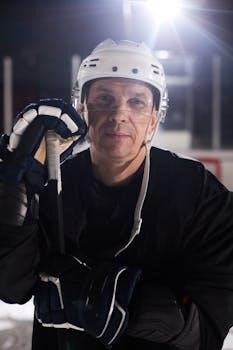
Additional Resources and Conclusion
For more hockey terms, explore resources like USA Hockey and Hockey Canada. Online glossaries and fan sites offer further information. Continued learning enhances understanding and appreciation.
Where to find more hockey terminology resources
Numerous resources exist for those looking to expand their knowledge of hockey terminology. Official organizations such as USA Hockey and Hockey Canada provide comprehensive glossaries and guides on their websites. These resources often include definitions of rules, skills, and strategies. Online sports websites and fan forums are also invaluable for finding both formal and informal hockey terms, including slang used by players and fans. Interactive online glossaries offer user-friendly platforms to explore specific terms. Furthermore, many hockey training programs and coaching websites include detailed terminology sections to support skill development. Checking out these different places ensures a well-rounded understanding of the language of hockey.
